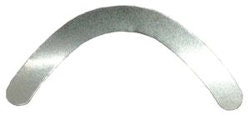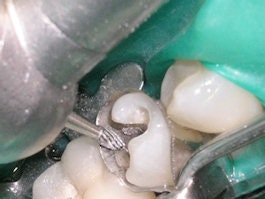
Q: When doing posterior composites, what are you using for your class II matrix?
A: There are a lot of matrix systems available that all claim to create the perfect morphology and contact with adjacent teeth. I like to say "one size fits many, but not all." I believe you do need more than one matrix system in your toolbox.
I am currently using the Triodent V3 Ring along with their Wedge Guard. I also am using the Greater Curve Toffelmire Bands. The Triodent V3 Rings and Wedge Guard make protecting adjacent teeth and establishing a good contact easy.



First, I place the Wedge Guard. The wedge is designed not only to protect the adjacent tooth structure but the papilla as well. This allows you to prepare the teeth much faster, reducing treatment time.
After cavity prep, the guard is detached while the wedge stays in place, ready for the insertion of a matrix beside it. Leaving the wedge in place prevents reactive hyperemia, ensuring a cleaner working area.
I then place the Triodent V3 Matrix Band and Ring.

The composite is then placed and light cured. The special forceps make placing and removing the matrix band easy.
When the preparation is very large and sectional matrix band are too small, I use the Greater Curve Bands.
After you finish your preparation, the band is placed in a conventional matrix band holder. A football finishing bur is used to create a window in the band.

You have complete control of the size and placement of the contact. If you want a broad contact, it is easily established. After establishing your contact window, you burnish the band against the adjacent tooth. No wedging of the tooth is usually necessary.
No matter what system you use it can sometimes be difficult to remove the matrix band. For those situations, consider the Garrison Composi-Tight Matrix.
The tungsten carbide tips provide exceptional grip and tactile control for tough access cases.
That is what I am using in my practice to get good contact for my class II restorations.



















